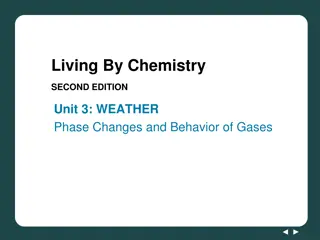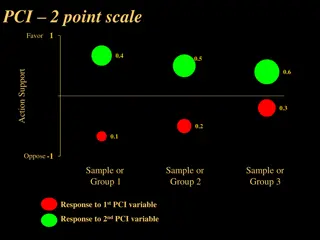Understanding Scoring Scales: Meaning, Calculation, and Advantages
Scoring scales are used to assign numerical values to observations for quantifying attributes or behaviors in various fields. They provide a systematic way to evaluate or measure variables, convert qualitative data into quantitative data, and facilitate analysis and interpretation. This article discusses the meaning, calculation, and advantages of scoring scales, including types of derived scores, standard scores, and the process of calculating scores based on predefined criteria.
Download Presentation

Please find below an Image/Link to download the presentation.
The content on the website is provided AS IS for your information and personal use only. It may not be sold, licensed, or shared on other websites without obtaining consent from the author. Download presentation by click this link. If you encounter any issues during the download, it is possible that the publisher has removed the file from their server.
E N D
Presentation Transcript
MEANING CALCULATION AND MEANING CALCULATION AND ADVANTAGE OF SCORING SCALE ADVANTAGE OF SCORING SCALE BY DR.VIPENDRA PARMAR VSSD COLLEGE
MEANING CALCULATION AND ADVANTAGE OF SCORING SCALE:- A scoring scale is a method used to assign numerical values to observations or responses in order to quantify certain attributes or behaviors. It's commonly used in various fields such as education, psychology, market research, and performance evaluation. Here's a breakdown of its meaning, calculation, and advantages: Meaning of Scoring Scale: A scoring scale provides a systematic way to evaluate or measure different variables, traits, or characteristics. It allows for the conversion of qualitative data into quantitative data, making it easier to analyze and interpret.
SCORE According to Ross A score on any test is simply a numerical description of an individual s performance on that task. According to Smith Raw Scores are direct counts of the number of items a specified event has occurred, such as - the number of test items answered correctly, the number of books read, the number of errors made in solving a problem, the number of statements endorsed on a questionnaire, etc.
Types of Derived Scores: Z- Scores T- Scores C-Scores Stanine Scores Hull Scores , etc
Standard Scores The standard scores represent measurements from the mean in S.D. units. The standard score indicates how far a particular score is removed from the mean of the distribution in terms of S.D. of the distribution. Standard scores conform to the concept of the normal distribution. In case of standard scores, the difference between score units are hypothesized to be equal.
Calculation of Scoring Scale: The calculation of a scoring scale depends on the specific context and purpose. However, it typically involves assigning numerical values to different levels or categories of a variable based on predefined criteria. These values are then to taled or averaged to obtain a score for each observation or respondent. For example, in a Likert scale used to measure attitudes, respondents might be asked to rate their agreement with statements on a scale of 1 to 5, where 1 represents "strongly disagree" and 5 represents "strongly agree". The scores for all the statements are then added up to get a total score for each respondent.
Advantages of Scoring Scale: 1. Standardization: Scoring scales provide a standardized way to measure and compare observations or responses. This allows for consistency across different evaluators or time periods. 2. Quantification: By assigning numerical values to qualitative data, scoring scales allow for quantitative analysis. This makes it easier to identify patterns, trends, and relationships in the data. 3. Ease of Interpretation: Scores obtained from scoring scales are relatively easy to interpret compared to raw qualitative data. They provide a clear indication of the level or intensity of a particular attribute or behavior. 4. Efficiency: Scoring scales streamline the evaluation process by providing a structured framework for assessment. This can save time and resources compared to more subjective or ad-hoc methods of evaluation. Facilitates Decision Making: Scoring scales provide objective criteria for decision making. They help stakeholders make informed
Overall, scoring scales are valuable tools for researchers, educators, and practitioners alike, offering a reliable and efficient way to assess and quantify various attributes and behaviours.
T SCALE :- Calculation of T Scale: The calculation of a T score involves three main steps: 1. Standardization: The individual's raw score on the test is converted into a standardized score using the mean and standard deviation of the reference population. This is done using the formula: T=50+10 ( X ) Where: T = T score X = individual's raw score = mean of the reference population = standard deviation of the reference population
1.Interpretation: Once the T score is calculated, it can be interpreted in relation to the mean and standard deviation of the reference population. A T score above 50 indicates that the individual scored above the average of the reference group, while a T score below 50 indicates a score below the average. 2.Comparison: T scores allow for easy comparison between individuals or groups, as they are standardized and have a consistent metric across different tests or assessments.
Advantages of T Scale: Standardization: T scores provide a standardized metric that allows for easy comparison across different populations and tests. Easy Interpretation: T scores are easy to interpret, with a mean of 50 and a standard deviation of 10 providing a clear reference point. Flexibility: T scores can be used with various types of assessments and tests, making them widely applicable in different fields. Normalized Distribution: T scores are based on a normal distribution, making them suitable for statistical analysis and interpretation. In summary, the T scale is a standardized score used to compare an individual's performance to a reference population. It provides a convenient and interpretable metric for assessing and comparing test scores across different contexts. In summary, the T scale is a standardized score used to compare an individual's performance to a reference population. It provides a convenient and interpretable metric for assessing and comparing test scores across different contexts.
6 SIGMA SCALE:- The Six Sigma scale is a statistical concept and methodology widely used in quality management and process improvement to measure the level of defects or errors in a process. It aims to minimize variation and improve quality by identifying and eliminating defects. Here's an explanation of the Six Sigma scale: Meaning of Six Sigma Scale: The term "Six Sigma" refers to a level of quality that strives for near perfection in products, services, and processes. It represents a statistical measure of how far a process deviates from perfection. In statistical terms, a process that operates at Six Sigma quality has a defect rate of fewer than 3.4 defects per million opportunities (DPMO).
Calculation of Six Sigma: The calculation of Six Sigma involves measuring the process variation in standard deviations from the mean. The term "sigma" ( ) represents the standard deviation of a process. The higher the number of sigmas, the lower the defect rate and the higher the process capability. To calculate the sigma level, the following formula is used: Sigma Level=Total Opportunities Total DefectsTotal OpportunitiesSigma Level= Total OpportunitiesTotal Opportunities Total Defects
Advantages of Six Sigma Scale: 1.Focus on Quality: Six Sigma focuses on improving quality by reducing defects and variability in processes, leading to higher customer satisfaction. 2.Data-Driven Approach: It emphasizes data analysis and statistical methods to identify root causes of defects and make informed decisions for process improvement. 3.Customer-Centric: Six Sigma places a strong emphasis on understanding customer requirements and delivering products and services that meet or exceed customer expectations.
1. Process Improvement: It provides a structured methodology and tools (such as DMAIC: Define, Measure, Analyze, Improve, Control) to systematically improve processes and achieve measurable results. 2. Cost Reduction: By reducing defects and improving efficiency, Six Sigma can lead to cost savings for organizations through decreased rework, scrap, and warranty claims. 3. Organizational Culture: Implementing Six Sigma fosters a culture of continuous improvement and excellence within an organization, with employees actively engaged in identifying and solving problems. In summary, the Six Sigma scale is a powerful tool for organizations to achieve and sustain high levels of quality and efficiency in their processes. By focusing on data-driven decision making and continuous improvement, Six Sigma helps organizations deliver superior products and services to customers while reducing costs and increasing profitability
Z SCALE :- The Z-scale, also known as the standard score or z-score, is a statistical measure that quantifies how many standard deviations a data point is from the mean of a dataset. It's a dimensionless quantity and is particularly useful for comparing data points from different distributions or variables. Here's an explanation of the Z- scale: Meaning of Z-Scale: The Z-score indicates how much a particular data point deviates from the mean of the dataset in terms of standard deviation units. A positive Z-score indicates that the data point is above the mean, while a negative Z- score indicates that the data point is below the mean. A Z-score of 0 means that the data point is exactly at the mean of the dataset.
Calculation of Z-Scale: The Z-score is calculated using the following formula: Z= X Where: Z = Z-score X = Data point = Mean of the dataset = Standard deviation of the dataset
Interpretation of Z-Scale: Once the Z-score is calculated, it can be interpreted as follows: A Z-score of 0 indicates that the data point is at the mean of the dataset. A positive Z-score indicates that the data point is above the mean. A negative Z-score indicates that the data point is below the mean. The magnitude of the Z-score indicates how many standard deviations the data point is from the mean. For example, a Z-score of 2 means that the data point is 2 standard deviations above the mean.
Advantages of Z-Scale: 1. Standardization: Z-scores provide a standardized metric for comparing data points from different datasets or variables. 2. Normalization: Z-scores transform data into a standard normal distribution with a mean of 0 and a standard deviation of 1, making it easier to analyze and interpret. 3. Outlier Detection: Z-scores can be used to identify outliers in a dataset by flagging data points that fall beyond a certain threshold (e.g., Z-score greater than 3 or less than -3).
1.Relative Comparison: Z-scores allow for relative comparisons between data points, helping to identify which data points are relatively higher or lower than others within the dataset. In summary, the Z-scale is a useful statistical measure for standardizing and comparing data points across different distributions or variables. It provides a standardized metric that facilitates analysis, interpretation, and comparison of data within a dataset.
HULL SCALE : - In statics, the term "hull scale" might be referring to a concept related to structural engineering or the analysis of structures. However, there's no widely recognized concept or methodology called the "hull scale" in statics that I'm aware of. It's possible that the term might be a colloquialism, a regional term, or a specific concept used in a particular context. If you're referring to a specific concept related to structural analysis or statics, but using a different term, please provide more details or context, and I'd be glad to help explain it. Alternatively, if you've encountered the term "hull scale" in a specific textbook, paper, or course material, providing more information about the source might help clarify its meaning.























